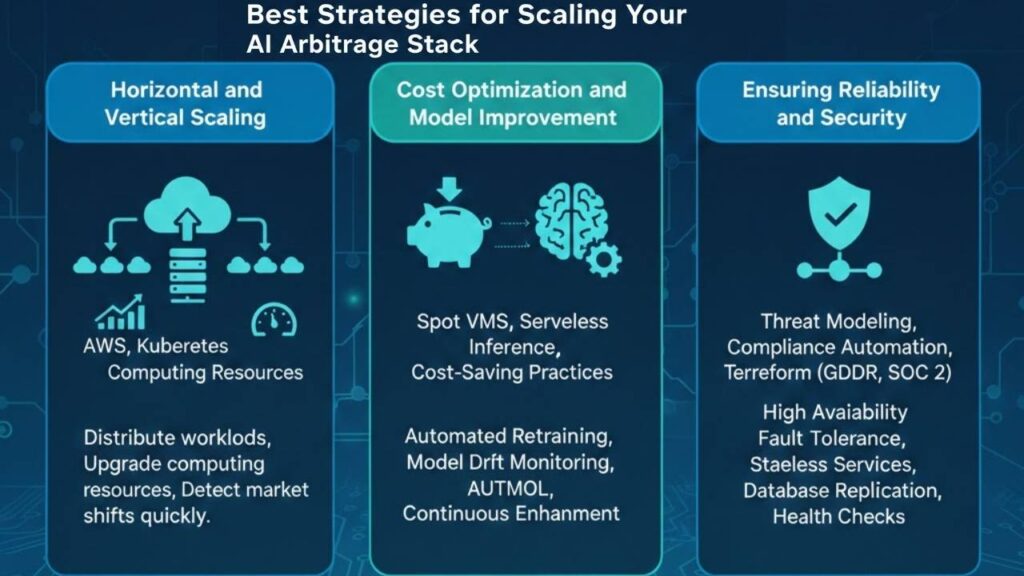You are poised at the forefront of a transformative era where AI arbitrage presents both remarkable opportunities and formidable challenges. As a professional navigating this intricate domain, you must comprehend the nuances that define AI arbitrage, a practice that leverages inefficiencies in AI markets to generate profit.
This article will guide you through the complexities of AI arbitrage, examining the potential for innovation and growth while addressing the inherent risks and ethical considerations. By understanding these dynamics, you can better position yourself to capitalize on the opportunities AI arbitrage offers.
What Is AI Arbitrage and How Does It Work?
AI Arbitrage leverages artificial intelligence to capitalize on fleeting price differences across various markets or exchanges. By employing AI-driven bots, traders can execute trades automatically, seizing opportunities quicker than any human could adapt our tools. These systems integrate machine learning for real-time market analysis, optimizing their strategies as conditions change. Despite its promise, AI Arbitrage requires careful risk management and constant monitoring.
The Core Components of a Scalable AI Arbitrage Stack
Data Acquisition & Processing
A robust AI Arbitrage system begins with efficient data acquisition and real-time processing capabilities. Implementing event-driven pipelines and serverless computation enhances the ability to handle large data volumes, ensuring accurate analysis. Integrating scalable cloud databases is crucial for maintaining data integrity and providing a solid foundation for further operations required by AI agents.
Machine Learning & Automation
Effective AI Arbitrage relies heavily on machine learning models to identify potential arbitrage opportunities. Deploying these models includes training, monitoring, and refining them continually. This setup promotes adaptability to evolving market conditions. Automation and orchestration frameworks, such as Apache Airflow and Prefect, streamline complex data workflows, enabling seamless operations and enhancing decision-making in AI applications.
Security and Compliance
Navigating the intricacies of security and compliance is vital for any AI arbitrage endeavor. Integrating secure APIs and managing permissions protect sensitive data and trading activities. Ensuring adherence to regulatory standards through robust compliance protocols ensures the ethical and legal deployment of AI solutions, fostering trust and credibility in AI Arbitrage as seen in trading bot systems.
Observability & Monitoring
Maintaining a sharp focus on observability and monitoring is essential. Comprehensive systems track the health of AI operations, alerting teams to model performance shifts or anomalies. This proactive approach enables rapid response and maintains system efficacy, critical for robust AI Arbitrage operations.
Best Strategies for Scaling Your AI Arbitrage Stack

Horizontal and Vertical Scaling
Incorporating horizontal and vertical scaling is essential for expanding your AI arbitrage stack. Horizontal scaling involves distributing workloads across cloud platforms like AWS or Kubernetes, which supports efficient analysis of financial markets. In contrast, vertical scaling focuses on upgrading computing resources. This ensures that your AI arbitrage operations can quickly detect market shifts and execute strategies, enhancing speed and performance.
Cost Optimization and Model Improvement
To sustainably scale your AI arbitrage operations, implement cost-saving practices like using spot VMs and serverless inference. It’s also crucial to continuously enhance AI models through automated retraining pipelines, monitoring for model drift, and exploring advanced techniques like AutoML. This continual improvement enables traders to operate at peak efficiency and maintain a competitive edge in dynamic markets.
Ensuring Reliability and Security
Building a reliable AI arbitrage system requires high availability and robust fault tolerance. Use stateless services, database replication, and health checks to ensure resilience against market volatility. Enhance security through rigorous threat modeling and compliance automation, employing tools like Terraform for GDPR and SOC 2 compliance. This approach secures operations and upholds trader confidence.
Can You Really Make Money With Arbitrage?
AI Arbitrage offers a fascinating avenue for profit, albeit with challenges. The ability to capitalize on fleeting market inefficiencies presents lucrative opportunities, particularly in sectors like cryptocurrency. Engaging in AI Arbitrage with speed and precision is crucial, as these opportunities are intensely competitive and quickly vanish. Yet, for those equipped with advanced technology and strategic insights, there is potential to generate substantial returns.
Is AI Arbitrage Profitable?
AI Arbitrage offers opportunities for consistent profits by exploiting temporary price discrepancies across platforms. Its ability to generate gains in bear or sideways markets makes it an attractive option for cautious investors. However, challenges such as transaction fees and trading risks can erode profits. As technology and market liquidity evolve, AI Arbitrage remains a viable, albeit competitive, strategy for skilled traders exploiting arbitrage opportunities.
What Is the Best AI Arbitrage App?
Financial Arbitrage Applications
When considering the best AI arbitrage tools for financial markets, Cryptohopper stands out with its cloud-based crypto bot platform, offering market and triangular arbitrage features. For automated trading, 3Commas provides a simple interface combined with DCA/Grid bots. Meanwhile, Pionex allows users to implement a one-click spot-futures arbitrage bot. These solutions harness AI for effective, profitable market strategies.
Retail Arbitrage Solutions
In the realm of retail, Tactical Arbitrage offers a powerful sourcing engine scanning retailer catalogs against Amazon’s to identify profitable opportunities. On the user experience front, Source Mogul simplifies online arbitrage. Additionally, AMZScout provides an AI-assisted Amazon research tool, optimizing sales estimate processes and fee calculations for a clear competitive edge.
Is Trading Arbitrage Illegal? Understanding the Legal Landscape
Arbitrage trading is generally legal across most jurisdictions, as it promotes market efficiency by eliminating price discrepancies. However, it becomes illegal when it overlaps with unethical practices like insider trading or market manipulation, which are heavily regulated. Always verify local laws to ensure compliance with trading regulations.
Emerging Trends in AI Arbitrage Trading
Modular AI Tech Integration
AI arbitrage is significantly evolving through the adoption of modular, cloud-native architectures. These frameworks boast trading bots, predictive analytics, and scalable automation across various exchanges. The trend of integrating low-code tools with customized AI solutions enables enhanced adaptability and speed in managing market fluctuations. Unified infrastructure allows fast retraining, which is critical for real-time arbitrage trading, ensuring robustness against volatile conditions.
AI-Driven Adaptive Systems
The transformation of AI-driven bots from basic automation to sophisticated adaptive systems marks another emerging trend. These bots, indispensable for both crypto and financial markets, utilize faster data pipelines and model-driven execution. This approach significantly boosts the AI arbitrage landscape by identifying opportunities across spot and futures markets, optimizing trades with precision, and enhancing AI forecasts to preemptively anticipate spreads.
Enhanced Risk Management
Advanced risk management techniques are becoming a staple of the future AI arbitrage landscape. Automated stop-loss triggers, comprehensive exposure monitoring, and compliance-aware models aim to protect both institutional and retail traders. This integration of AI with risk management protocols not only mitigates risk but also enhances strategic planning by allowing real-time adjustments to market conditions.
AI Arbitrage in Emerging Markets
With the globalization of trading, AI arbitrage is expanding into emerging markets. These markets, especially in currency sectors, offer substantial opportunities due to disparities in interest and exchange rates. AI systems allow companies to identify real-time inefficiencies and execute trades with precision, navigating regulatory and political risks associated with these markets.
This comprehensive approach showcases the immense potential and challenges within AI arbitrage, emphasizing the essential role of cutting-edge AI technology and strategic market adaptation.
Conclusion
As you delve into the intricate world of AI arbitrage, it becomes evident that the opportunities are boundless, yet not without substantial challenges. By leveraging AI’s capabilities, you can harness unprecedented efficiencies and insights, driving strategic decisions that were once unimaginable. However, navigating the ethical, technical, and regulatory landscapes requires vigilance and adaptability. By maintaining a forward-thinking approach, you can position yourself at the forefront of this evolving discipline. Ultimately, understanding and mastering AI arbitrage not only enhances your competitive edge but also prepares you to tackle the complexities of a rapidly advancing digital economy with confidence and precision.
See Also: What Is LANGSEC? A Primer on the Language-Theoretic Security Approach










